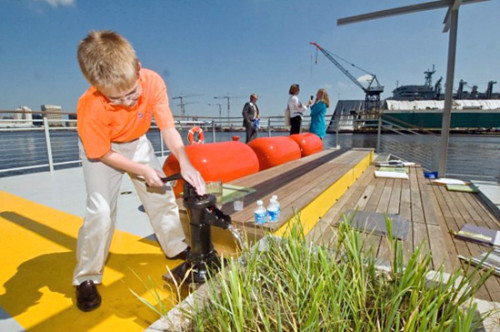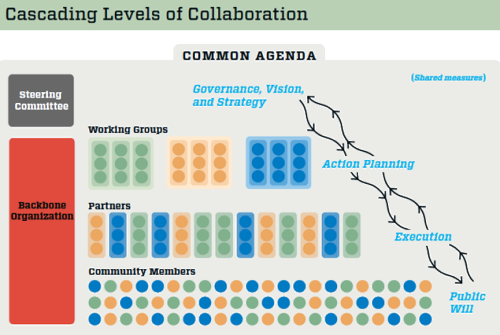Kick-starting Collective Impact in Five Easy Report Card Steps
Heath Kelsey ·This is the first of two posts about the application of report cards to enable a collective impact process.
The collective impact model facilitates positive change
Collective Impact is a term used to refer to collaborative projects that create “needle-moving” changes to complex and intransigent problems. I ran across the term for the first time a few days ago, and it resonated strongly with me. It puts a name to many of the principles of the engagement process and conceptualization that we strive for in our report card projects. The term was coined in 2011 by John Kania and Mark Kramer in a seminal paper in the Stanford Social Innovation Review, in which they define Collective Impact as a collaborative effort of multiple stakeholders centered on a common agenda and a shared vision.
But it’s not just collaboration. In reviewing why many years of dedicated work by non-profits often didn’t result in overall change, the authors realized that single-issue advocacy just doesn’t work - even when multiple groups collaborate. Initiatives too numerous to count have touted their successes in achieving their programmatic objectives, but have failed to change the overall status of the problem they were trying to solve. This is true in education, public health, environment, and many other areas.
To contrast with projects that actually did result in measureable change, the authors provide several case studies, including Strive, which is an education program in the Cincinnati, Ohio area, and the Elizabeth River Project in southern Virginia. These projects have succeeded because of the involvement of diverse stakeholders at early stages, a common vision for the future and an agenda for getting there, and common measurement systems.

The Collective Impact model requires a shared vision for change developed through an inclusive process involving all stakeholders, trust among the participants, common measures to assess progress toward achieving change, and time to develop these elements. Many successful programs required years to develop these elements. Kania and Kramer list 5 components of successful collective impact projects:
- Common Agenda. All stakeholders and partner organizations need to be working from the same sheet of music to achieve a shared vision and goals.
- Shared Measurement Systems. To assess progress toward achieving the goals of the vision and agenda, everyone needs to be assessing things in the same way.
- Mutually Reinforcing Activities. Organizations have different strengths and missions, but each should be engaged in activities that are supportive of the shared vision and agenda.
- Continuous Communication. Developing the shared agenda, the measurement systems, and the trust necessary to achieve them requires more than a few phone conversations or a meeting or two. The conversations need to be ongoing over a long period.
- Backbone Support Organizations. To be successful, it takes an organization (often more than one) that can coordinate, shepherd, and facilitate the process.

This process requires multiple stakeholders to change their behavior and pursue a shared goal, rather than pursuing the singular objectives represented by their professional perspectives and single-issue advocacy. This requires participants to take off their professional or organizational hats, and put on the hat of a citizen who wants to make a positive difference.
Report Cards provide a rallying point for a Collective Impact approach
Without realizing that we were doing it, many of our report card projects are providing a concrete rallying point to facilitate a collective impact process. The 5 steps of the report card process present excellent opportunities to implement many of the principles of the collective impact model:
Step 1. Conceptualization. Our conceptualization step grew out of a need to visualize discrete environmental problems and processes so that we could not just communicate them, but could identify the values, resources, threats, and processes that were most important. The key component of the conceptualization process is that we facilitate discussion among multiple stakeholders to clarify these key components, and develop a common language to describe the issues.
Step 2. Identify Indicators. This step identifies the common measures that will be required to assess the status of the problems identified in the previous step. Again, this is a facilitated discussion among many stakeholders.
Step 3. Identify Thresholds. The facilitated conversation continues, with the goal of establish desired conditions for the indicators chosen in Step 2. By identifying what success looks like for each indicator, this process can help describe the shared vision that Kania and Kramer identify as so important for successful outcomes.
Step 4. Calculate Scores. This step is surprisingly important. One would think that after identifying the indicators, data, and thresholds for measurements, the calculation step would be easy. In fact, it can be quite difficult and nuanced, and the discussions around this step provide opportunity for continued communication among group participants specifically about what the current status looks like, and the vision for success in each area. Tied to this is the way that measures can be aggregated to measure overall success.
Step 5. Communicate Results. The report card document is much more than outreach that summarizes the results of an assessment. The publication of the report card symbolizes the collective efforts of the various stakeholders that participated in the process to identify a shared vision for the future. This concrete realization of these efforts provides the catalyst for the earlier steps, and enables the process to take place. At the outset of the first meeting, participants are assured that a printed document will be produced that presents the efforts of all participants.
Continuous communication is encouraged throughout the 5-step process, although budget ad time limitations can be a hurdle to achieving that. The first three steps are mostly addressed in a workshop setting. Depending on several factors, including the scope of the region and issues, the workshop can involve participants representing numerous stakeholder perspectives, and can span several days. We often plan follow-up conference calls and webinars, and follow-up workshops at interim steps.
As facilitators of the report card workshops and meetings, we act as one of the backbone organizations that coordinate and facilitate the collective impact process!
As it turns out, some of our partners were well ahead of us in using the report card as part of the implementation of a collective impact approach. I’ll discuss some of them in my next blog.
About the author
Heath Kelsey

Heath Kelsey has been with IAN since 2009, as a Science Integrator, Program Manager, and as Director since 2019. His work focuses on helping communities become more engaged in socio-environmental decision making. He has over 15-years of experience in stakeholder engagement, environmental and public health assessment, indicator development, and science communication. He has led numerous ecosystem health and socio-environmental health report card projects globally, in Australia, India, the South Pacific, Africa, and throughout the US. Dr. Kelsey received his MSPH (2000) and PhD (2006) from The University of South Carolina Arnold School of Public Health. He is a graduate of St Mary’s College of Maryland (1988), and was a Peace Corps Volunteer in Papua New Guinea from 1995-1998.

